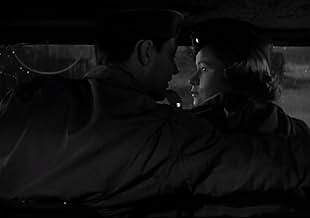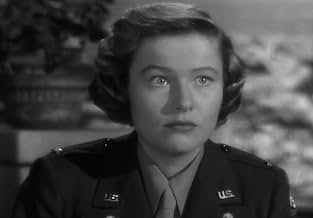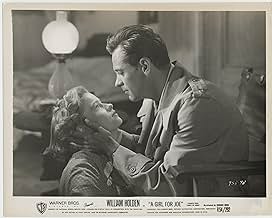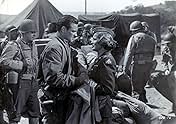During World War II in Italy, an American sergeant and WAC lieutenant take time out for romance.During World War II in Italy, an American sergeant and WAC lieutenant take time out for romance.During World War II in Italy, an American sergeant and WAC lieutenant take time out for romance.
- Director
- Writers
- Stars
- Awards
- 1 win total
Argentina Brunetti
- Signora Maduvalli
- (uncredited)
Francesco Cantania
- Barber
- (uncredited)
Frances Canto
- WAC
- (uncredited)
Philip Carey
- Military Police Sgt. Fred Miller
- (uncredited)
Amelia Cova
- Lea Maduvalli
- (uncredited)
Ashley Cowan
- Patient
- (uncredited)
Danny Davenport
- Driver
- (uncredited)
Anna Demetrio
- Mamma Mia
- (uncredited)
- Director
- Writers
- All cast & crew
- Production, box office & more at IMDbPro
Featured reviews
I wasn't sure what to make of this at first since I had never heard of the movie before I saw it on Turner recently, but almost right off the bat this earnest war/romance drama shows it's mettle.
William Holden is a GI on a short leave in Naples during the Allied advance up Italy. He meets WAC Nancy Olson , and after a short resistance on her part they fall in love , more or less at first sight. I liked the dialog between the two of them during this 'courtship' , it is well written and though Holden plays the wisecracker he so often did in his roles, it seems natural in these scenes.
The rest of the film tracks their time in Italy, together and apart, as Holden returns to the front and faces the need to prove his courage and cool under fire.
The thing that made this movie stand out is the treatment of a war time in service romance that is neither played for laughs or pathos. It is slightly melodramatic at times, but appropriately so for the material.
One of the better films of this type I have seen.
William Holden is a GI on a short leave in Naples during the Allied advance up Italy. He meets WAC Nancy Olson , and after a short resistance on her part they fall in love , more or less at first sight. I liked the dialog between the two of them during this 'courtship' , it is well written and though Holden plays the wisecracker he so often did in his roles, it seems natural in these scenes.
The rest of the film tracks their time in Italy, together and apart, as Holden returns to the front and faces the need to prove his courage and cool under fire.
The thing that made this movie stand out is the treatment of a war time in service romance that is neither played for laughs or pathos. It is slightly melodramatic at times, but appropriately so for the material.
One of the better films of this type I have seen.
It would be easy to pass off Force of Arms as just another post-WWII action/romance movie until you're a few frames into viewing it. Surprisingly realistic with actual combat footage interspersed with filming. Strong yet sensitively-understated performances by Holden, Olson, and, in a supporting role, Frank Lovejoy. An inspired and superior script helps convey the chaos of combat, its effects on those who are scarred by it, and the powerful force of love that can somehow emerge in the midst of the sheer will to survive. A classic that feels as real in 2017 as when it was filmed.
The original story behind Force of Arms was written by Richard Tregaskis, war correspondent from World War II, best known for Guadalcanal Diary. Of course some would argue that Tregaskis borrowed a lot of the plot from the previous war that Ernest Hemingway chronicled in A Farewell to Arms.
Still it's a nice romantic story brought to life by the teaming of William Holden and Nancy Olson who did four films together back at this time. Nancy Olson in fact got an Oscar nomination in the Best Supporting Actress category for Sunset Boulevard which was their first film together.
After his company is relieved on the San Pietro front in the Italian theater, William Holden meets WAC Nancy Olson and a romance blooms. But it's back to the front, in fact Holden gets himself wounded twice during the course of Force of Arms.
Actual combat footage from the Italian campaign is used along with newsreels from the liberation of Rome where the climax takes place. There are good performances here also by Frank Lovejoy and Katherine Warren as the respective commanding officers of Holden and Olson.
This was Bill Holden's first great romantic role along the lines of Humphrey Bogart in Casablanca. It's a harbinger of what we would later get from him in films like The Bridges of Toko-Ri and Love Is A Many Splendored Thing.
It's a sadly neglected film, one of Bill Holden's better films and should not be missed.
Still it's a nice romantic story brought to life by the teaming of William Holden and Nancy Olson who did four films together back at this time. Nancy Olson in fact got an Oscar nomination in the Best Supporting Actress category for Sunset Boulevard which was their first film together.
After his company is relieved on the San Pietro front in the Italian theater, William Holden meets WAC Nancy Olson and a romance blooms. But it's back to the front, in fact Holden gets himself wounded twice during the course of Force of Arms.
Actual combat footage from the Italian campaign is used along with newsreels from the liberation of Rome where the climax takes place. There are good performances here also by Frank Lovejoy and Katherine Warren as the respective commanding officers of Holden and Olson.
This was Bill Holden's first great romantic role along the lines of Humphrey Bogart in Casablanca. It's a harbinger of what we would later get from him in films like The Bridges of Toko-Ri and Love Is A Many Splendored Thing.
It's a sadly neglected film, one of Bill Holden's better films and should not be missed.
Just caught it on Turner. The reviews calling it "routine" show how dull-normal some people are. In fact, the old pro Michael Curtiz (look him up) brings an extraordinary sensibility to the film. Gone are his romantic stylings of Casablanca and Robin Hood, his lush, overdone Warner's agreeable foolishness. Instead, he portrays war as bitter and without glory, full of random death and meaningless violence. The three combat sequences are superb, and Holden, as he would later demonstrate in "Bridge on the River K" is brilliant as a reluctant soldier who has no sense of glory and no wish to be a hero, but is nevertheless the everyman Infantryman, who knows he must do his duty. Curtiz doesn't turn this evocation of battle into boy's fantasy; it's hard, bitter, terrifying and brutally unfair to children and especially young American men who never thought they'd be dying in the slopes of Mt. Casino. The romance is nicely done, even if the ending is trite (but, in the way that cheap melody can be, amazingly satisfying). Olsen and Holden have great chem (as they proved in three other films as well) and all in all, the whole piece is kept in a register of near-realism that's very affecting. A neglected minor gem from the great Curtiz.
Forget San Pietro. The real conflict in this early 50s combat film is between anti war cynicism and patriotic effusion. The later wins out, as it almost always would in a pre 1960s Hollywood war movie, but the fact that there is even a spirited contest between the two ideologies shows just how far in the rear view mirror WW2, our only morally justified foreign engagement, had receded by 1951, especially once Korea had taken its place.
So if only as a marker of American society's changing views on war and flag waving this film would be worthy of notice. It is also the last good work of its director, the great Michael Curtiz*, who has at least two films in the top Hollywood 100 of the twentieth century (three if you're a "Yankee Doodle Dandy" fan, which I am not) featuring very realistic, hard bitten battle scenes.
Unfortunately, as previous reviewer planktonrules noted, the film is marred by some of the worst, gushy, mushy, cloyingly romantic dialogue, in the love scenes between William Holden and Nancy Olson, this side of a Fanny Hurst novel. I mean, Holden is a legitimately great actor but not even he can survive such lines as "With you I will live forever", spoken sincerely. And Olson, a much less skilled thesp, is completely done in by the lovey dovey twaddle composed by scenarist Orin Jannings, a scribe with whom I am thankfully not familiar.
Bottom line: Give it a generous B minus 'cause I'm a big Curtiz fan.
*There are some who regard 1958's "King Creole", with Elvis, as good. I am not among them.
So if only as a marker of American society's changing views on war and flag waving this film would be worthy of notice. It is also the last good work of its director, the great Michael Curtiz*, who has at least two films in the top Hollywood 100 of the twentieth century (three if you're a "Yankee Doodle Dandy" fan, which I am not) featuring very realistic, hard bitten battle scenes.
Unfortunately, as previous reviewer planktonrules noted, the film is marred by some of the worst, gushy, mushy, cloyingly romantic dialogue, in the love scenes between William Holden and Nancy Olson, this side of a Fanny Hurst novel. I mean, Holden is a legitimately great actor but not even he can survive such lines as "With you I will live forever", spoken sincerely. And Olson, a much less skilled thesp, is completely done in by the lovey dovey twaddle composed by scenarist Orin Jannings, a scribe with whom I am thankfully not familiar.
Bottom line: Give it a generous B minus 'cause I'm a big Curtiz fan.
*There are some who regard 1958's "King Creole", with Elvis, as good. I am not among them.
Did you know
- TriviaOne of 4 films that William Holden and Nancy Olson appeared in together, the others being Boulevard du Crépuscule (1950), Midi, gare centrale (1950), and Duel sous la mer (1951).
- GoofsIn this story set in the 1943 WWII Italian Campaign, Lieutenant MacKay and the other female characters all wear their hair shorter and their skirts longer, in the trending fashions of the early 1950s.
- Quotes
Sgt. Joe Peterson: You mean you were a civilian once?
Lt. Eleanor MacKay: Oh, if you consider schoolteachers civilians.
Sgt. Joe Peterson: You, honest?
Lt. Eleanor MacKay: Mm-hmm.
Sgt. Joe Peterson: Well, and me without an apple!
- ConnectionsFeatures La bataille de San Pietro (1945)
Details
- Release date
- Country of origin
- Languages
- Also known as
- Force of Arms
- Filming locations
- Malibu, California, USA(Serra Retreat)
- Production company
- See more company credits at IMDbPro
- Runtime1 hour 39 minutes
- Color
- Aspect ratio
- 1.37 : 1
Contribute to this page
Suggest an edit or add missing content
































